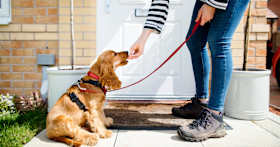Should I Let My Puppy Sleep with Me?
Before you enthusiastically cry out “yes,” it’s important to first consider your lifestyle and training goals.
Before you enthusiastically cry out “yes,” it’s important to first consider your lifestyle and training goals.
by Mollie Jackman, expert review by Mia Nguyen, CPDT-KA, FFCP | May 1, 2025

Svetlana / Adobe Stock
Bringing home a new puppy is a milestone filled with joy and big decisions. For instance, new puppy parents often wonder if they should let their puppy sleep with them. Because — let’s face it — it’s very tempting to snuggle next to that warm, cuddly little dog.
But your choice can impact your puppy’s behavior, your bond, and even your sleep quality. On one hand, co-sleeping can provide comfort and security for your puppy, helping them adjust to their new environment. On the other hand, it may lead to challenges with training, boundaries, or sleep patterns down the road.
Let’s explore the potential risks and benefits of co-sleeping with your puppy, so you can make the best decision for your situation.
Sleeping with your puppy is a personal choice, and for many new puppy parents, it’s a great way to bond with them. In fact, 56 percent of pet parents let their dogs share their bed. Puppies, like people, are social creatures who thrive on connection and companionship. Being near your puppy at night can help them feel safe and secure as they adjust to their new home. It’s also a chance to enjoy those sweet moments of closeness that make having a puppy so special.
For a little pup who’s just left their littermates, sleeping near you can ease the transition and reduce stress. Plus, being close lets you respond quickly if your puppy needs a bathroom break or comfort during the night. These small actions build trust and set the foundation for a strong relationship.
Here are some potential benefits to consider.
Enhanced emotional connection: Sharing a sleeping space can help your puppy feel more secure and loved, especially during their adjustment period in a new home.
Reduced nighttime anxiety: Your presence can ease separation anxiety, leading to fewer nighttime whimpers or barking — a win for you both!
Improved socialization: Puppies who are used to human contact during rest may grow up to be more confident and well-adjusted.
Easier nighttime care: If your puppy needs to go outside or simply wants reassurance, it’s easier to meet their needs without much hassle.
Comfort for both of you: New puppy parents often find co-sleeping comforting. Keeping your new pup nearby means you know they’re ok.
Faster adjustment: Puppies often settle into their new homes quicker when they spend more time with their humans.
Whatever you decide, remember that co-sleeping isn’t a one-size-fits-all solution. Some dogs may need more space than others, and people have different sleeping habits. The key is finding what feels right for you and your pup.
While co-sleeping can create a wonderful bond, it’s important to consider the potential challenges. We all know puppies are adorable, but they’re also energetic, curious, and sometimes noisy. Letting your new BFF sleep in your bed might bring some unexpected hurdles. By considering the downsides ahead of time, you can decide whether co-sleeping with your puppy is right for you.
Here are a few things to keep in mind.
Sleep disruptions: Puppies are naturally restless sleepers. They might shift, whimper at night, accidentally wake you up in the middle of the night, or even pee on the bed.
Boundary challenges: Sharing your bed early on can make it harder to establish boundaries later. If you decide to transition your puppy to their own bed down the road, they might resist the change.
Safety concerns: Puppies are small and vulnerable, especially in their first few months. You’ll need to be careful to prevent them from falling off your bed and not to roll onto them while you’re sleeping. While we’re on this topic, don’t forget to puppy-proof the rest of your home.
Allergies and hygiene: Even if your puppy is well-groomed, sharing a bed can mean dealing with fur, dander, or dirt they might carry in from outside.
These challenges don’t mean co-sleeping is a bad option — it just means it’s essential to weigh the pros and cons. For some families, the bond and comfort outweigh the downsides. For others, a separate sleeping arrangement might work better. Whatever you decide, flexibility is key. You can always adjust their designated sleeping area as your puppy grows and your needs evolve.
Co-sleeping isn’t just about comfort. It can also have a big impact on your puppy’s training and long-term behavior. Puppies are quick learners, and where they sleep often sets the tone for other parts of their routine.
Here’s how co-sleeping might influence your puppy’s training.
Crate training: If crate training is part of your plan, co-sleeping might slow progress. Puppies can get used to the comfort of your bed, making it harder for them to adjust to sleeping in their crate. For an option that works both ways, try keeping their crate in your room at bedtime.
Potty training: Co-sleeping can make potty training trickier. Your pup might have accidents without you noticing. In a crate or pen, pups often rustle or whine when they need to go. In your bed, they’re cozy and might not shift around or whine enough to wake you.
Reinforcing behaviors: Co-sleeping can reinforce positive behaviors, such as calmness and trust. But if your puppy wakes you up for play or attention, try not to give in. They’ll need to learn that your bedtime can’t be their playtime.
Transitioning challenges: If you plan to have your puppy sleep independently as a later puppy milestone, co-sleeping now could make the transition tougher. Puppies thrive on consistency, so changes to their routine might confuse them.
If you choose to share your bed, you can still set boundaries, like teaching your puppy to wait for permission to jump up. Consistency, patience, and clear expectations will help ensure co-sleeping works alongside your training goals.
While co-sleeping can be enticing, it doesn’t work for everyone. Luckily, there are plenty of other safe sleeping arrangements for puppies.
Check out these ideas for alternative sleeping arrangements.
Crate in your bedroom: Placing your puppy’s crate in your room lets them stay close to you without being in bed. It provides a safe, secure space and promotes good crate training at night.
Puppy bed beside your bed: Set up a cozy dog bed or mat next to your bed so your puppy can be near you but still have their own designated sleeping area.
Separate space with a baby monitor: If you prefer your puppy to sleep in a different room, consider using a baby monitor to watch them and respond if they need anything.
Gradual transition: If you want your puppy to eventually sleep in their own space, start with them near you and slowly move their bed or crate farther away over time.
Comforting items: Make your puppy’s sleeping space inviting — with soft bedding, a warm blanket, or a toy that smells like you — to help them feel secure. (Just be sure not to leave them alone with items they may be inclined to chew or eat.)
Finding the right sleeping arrangement is about what works for you and your puppy. With patience and consistency, you can create a setup that ensures you both get a good night’s sleep while building a strong, trusting bond.
At the end of the day, the best sleeping arrangement for you and your puppy is the one that fits your lifestyle, goals, and comfort level. Each puppy is different, and so is every family. What works perfectly for one might not suit another, and that’s okay. Trust your instincts, and don’t be afraid to adjust the sleeping arrangement if it’s not working.
Co-sleeping is just one option among many. If you choose to share your bed, you can enjoy the closeness and bonding it offers, while staying mindful of boundaries and training goals. If you decide on a different arrangement, know that your puppy can feel just as loved and secure in their own space.
Whether your puppy sleeps in your bed, in a crate, or on their own special mat, what matters most is that they feel safe, cared for, and part of the family. Considering the pros and cons is the first step toward creating a happy, healthy sleeping routine for you and your new pup.
It’s not necessarily bad to sleep with your dog in your bed. If your dog is healthy, clean, and well-behaved, this can be a comforting experience for both of you. However, if you have allergies or trouble sleeping, it might not be ideal. It’s all about what works best for you and your dog.
Dogs often want to sleep in bed with you because they feel safe and comfortable close to you. They see you as part of their family, and being near you provides warmth, security, and affection. It’s a way for them to bond with you and feel protected.
Yes, it can be safe to sleep with your dog in bed as long as your dog is healthy, clean, and free from parasites. Make sure to maintain good hygiene and check for any sleep disturbances or allergies. If your dog is well-groomed and you’re comfortable, it can be a great bonding experience.
Yes, Benadryl can be prescribed to calm dogs due to its drowsiness side effect. However, it’s not preferred as other medications and behavior modification techniques are more reliable. Additionally, while many dogs become drowsy, Benadryl can cause agitation in some.
Chomel, Bruno B., and Ben Sun. “Zoonoses in the Bedroom.” Emerging Infectious Diseases, vol. 17, no. 2, Feb. 2011, pp. 167–172, wwwnc.cdc.gov/eid/article/17/2/10-1070_article, https://doi.org/10.3201/eid1702.101070.
“Sleeping with Pets: Benefits and Risks.” Sleep Foundation, 14 Oct. 2021, www.sleepfoundation.org/animals-and-sleep/sleeping-with-pets.

Mollie Jackman is a writer, editor, and graduate of Lindenwood University’s MFA in writing. She’s also a pet parent to a goofy big-eared dog and two brown tabby cats, plus a rotating cast of foster animals. When she’s not reading, writing, or picking up strays, she can be found binge-watching arguably terrible reality TV shows and cooking competitions or rolling around the local skating rink in Columbia, Missouri. Mollie’s writing on this site is not in any way affiliated with the University of Missouri, or her work as a copywriter for MU Health Care.

Adoption Advice

Behavior & Training

Behavior & Training

Adoption Advice
The right timing can make all the difference in your puppy’s growth and behavior.

Adoption Advice

Behavior & Training
Make your pup a potty pro with these house training tips.

Adoption Advice
Are you new to dog adoption? We’ve got you covered with this comprehensive checklist. It’s everything a first-time pet parent needs to prepare for their new pup.

Adoption Advice
Adopting a dog with a difficult past doesn’t have to be a deal-breaker. Here’s how you can help them thrive in their new home.

Behavior & Training
Feeling overwhelmed by your very, very energetic dog? This comprehensive guide explores practical solutions to help calm your lively companion.